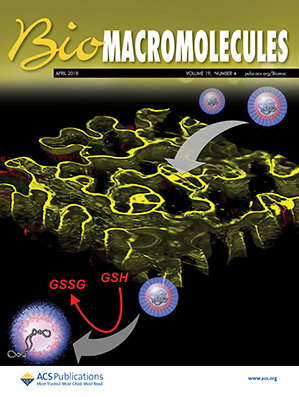Fast-Relaxing Hydrogels Promote Pancreatic Adenocarcinoma Cell Aggressiveness through Integrin β1 Signaling
IF 5.5
2区 化学
Q1 BIOCHEMISTRY & MOLECULAR BIOLOGY
引用次数: 0
Abstract
Pancreatic ductal adenocarcinoma (PDAC) is characterized by a dense extracellular matrix (ECM) exhibiting high stiffness and fast stress relaxation. In this work, gelatin-based viscoelastic hydrogels were developed to mimic the compositions, stiffness, and fast stress relaxation of PDAC tissues. The hydrogels were cross-linked by gelatin-norbornene-boronic acid (GelNB-BA), thiolated macromers, and a 1,2-diol-containing linear synthetic polymer PHD. Controlling the thiol–norbornene cross-linking afforded tunable stiffness, whereas increasing PHD content led to hydrogels with PDAC-mimicking fast stress relaxation. In vitro studies, including proliferation, morphology, and mRNA-sequencing, showed that fast-relaxing hydrogels supported PDAC cell proliferation, epithelial–mesenchymal transition (EMT), and integrin β1 activation. Blocking integrin β1 in vitro led to upregulating EMT markers in both slow and fast-relaxing hydrogels. However, this strategy profoundly impacted tumor growth rate and reduced tumor size but did not alter metastasis patterns in an orthotopic mouse model. This suggests a need to further evaluate the antitumor effect of integrin β1 blockade.
- Download: Download high-res image (75KB)
- Download: Download full-size image
求助全文
约1分钟内获得全文
求助全文
来源期刊

Biomacromolecules
化学-高分子科学
CiteScore
10.60
自引率
4.80%
发文量
417
审稿时长
1.6 months
期刊介绍:
Biomacromolecules is a leading forum for the dissemination of cutting-edge research at the interface of polymer science and biology. Submissions to Biomacromolecules should contain strong elements of innovation in terms of macromolecular design, synthesis and characterization, or in the application of polymer materials to biology and medicine.
Topics covered by Biomacromolecules include, but are not exclusively limited to: sustainable polymers, polymers based on natural and renewable resources, degradable polymers, polymer conjugates, polymeric drugs, polymers in biocatalysis, biomacromolecular assembly, biomimetic polymers, polymer-biomineral hybrids, biomimetic-polymer processing, polymer recycling, bioactive polymer surfaces, original polymer design for biomedical applications such as immunotherapy, drug delivery, gene delivery, antimicrobial applications, diagnostic imaging and biosensing, polymers in tissue engineering and regenerative medicine, polymeric scaffolds and hydrogels for cell culture and delivery.
 求助内容:
求助内容: 应助结果提醒方式:
应助结果提醒方式:


